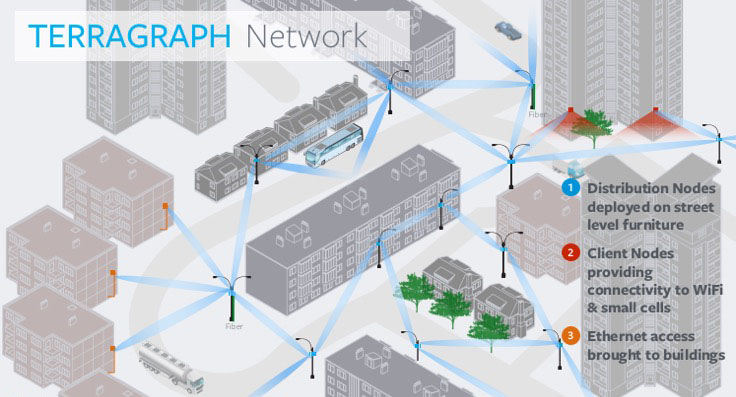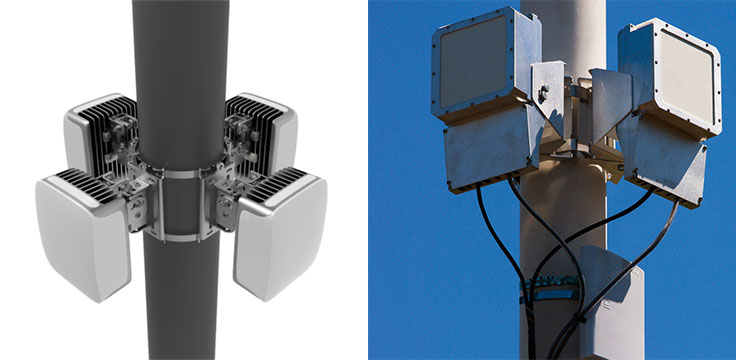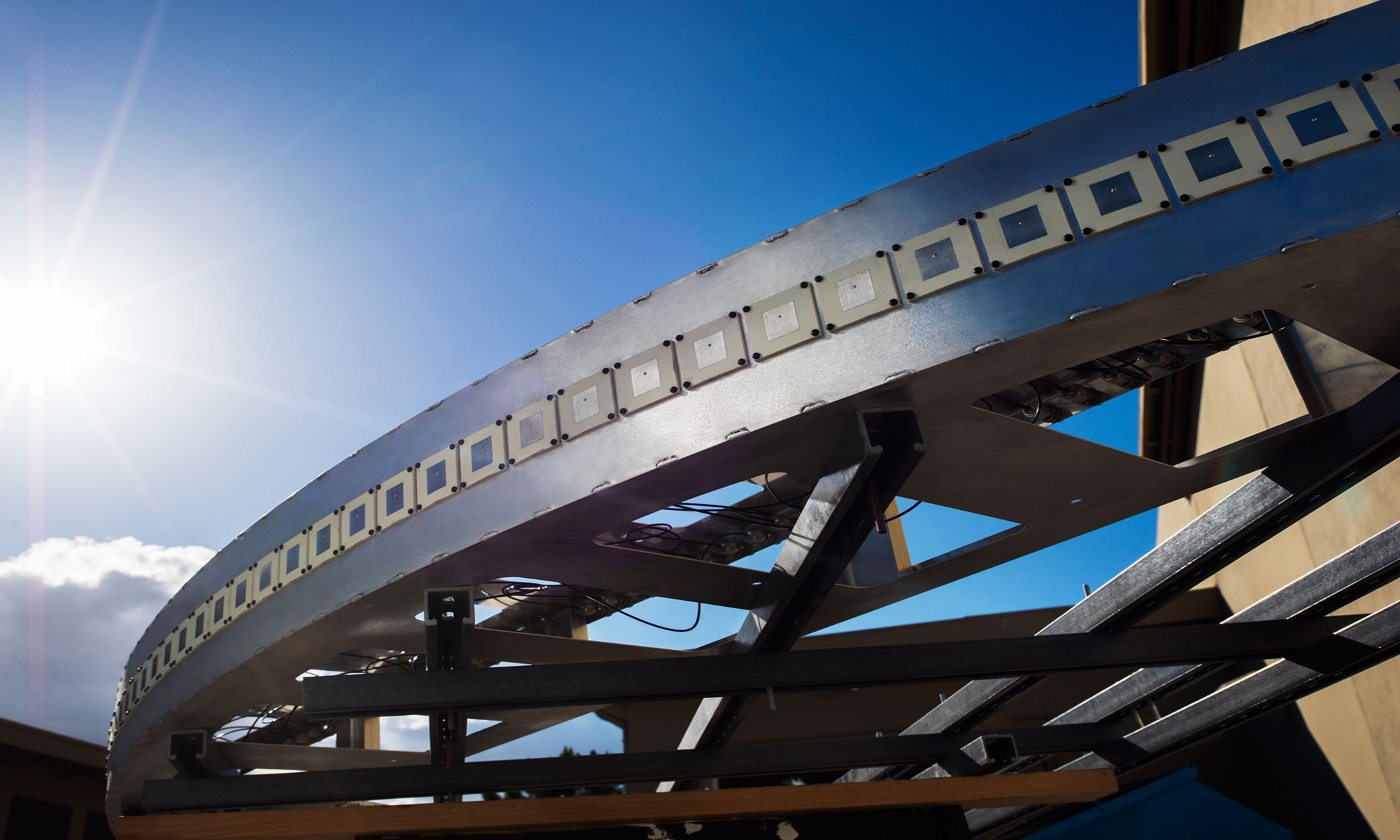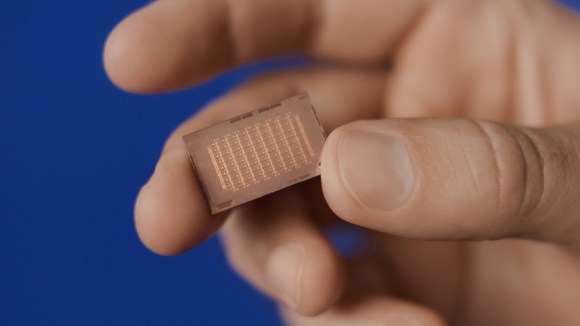Facebook believes that people — no matter where they live — deserve a consistent, high-bandwidth internet experience. While access to high-speed internet varies across the globe, both developing and developed economies can suffer from insufficient data rates. Slow internet speed is especially prevalent in developing economies where mobile networks are often unable to achieve data rates better than 2G. Developed economies are hampered by Wi-Fi and LTE infrastructure that is unable to keep up with the exponential growth in the consumption of photos and video at higher and higher resolutions.
While solutions such as GPON optical fiber can provide 100s of megabits up to several gigabits of capacity, the high costs associated with laying the fiber makes the goal of ubiquitous gigabit citywide coverage unachievable and unaffordable for almost all countries. Similarly, conventional means of increasing the capacity of wireless networks, such as licensing more radio frequency spectrum or installing more base stations, are costly and difficult in both urban and rural areas.
Facebook's Connectivity Lab is working on a range of new technology solutions to help connect the unconnected and improve the experience of the underserved. Today we announced two new terrestrial systems focused on improving the speed, efficiency, and quality of internet connectivity around the world — Terragraph and Project ARIES (Antenna Radio Integration for Efficiency in Spectrum).
Terragraph
Terragraph is a 60 GHz, multi-node wireless system focused on bringing high-speed internet connectivity to dense urban areas. Utilizing commercial off-the-shelf components and leveraging the cloud for intensive data processing, the Terragraph system is optimized for high-volume, low-cost production.
Delivering gigabits of capacity requires multiple gigahertz of spectrum via frequency reuse. Although 60 GHz has traditionally been avoided due to its high absorption of oxygen and water, countries such as the United States, United Kingdom, Germany, China, South Korea, Japan, and others saw the benefit of making this part of the spectrum — also known as “V-band” — unlicensed, similar to the Wi-Fi 2.4 GHz and 5 GHz bands. Up to 7 GHz of bandwidth is available in the 60 GHz band, and forward-thinking countries like the United States are seeking input to expand this to a total of 14 GHz.
One of the beneficiaries of this decision is WiGig, an enhancement to the Wi-Fi standard, designed to provide in-room high-bandwidth communication. Terragraph’s wireless system consists of radios that are based on the WiGig standard and are designed for consumer electronics, which allowed us to create nodes that are inexpensive relative to traditional telecom infrastructure.
Given the limited range of the 60 GHz signal, these nodes are placed across a city at 200-250 meter intervals. The vast bandwidth and unique signal-absorbing nature of the band limits interference and simplifies network planning, while the unlicensed nature of the spectrum helps to further minimize costs. Designed to provide street level coverage, Terragraph implements a phase array antenna to retain the highly directional signal required for 60 GHz, but makes it steerable to communicate over a wide area. Given the architecture of the network, Terragraph is able to route and steer around interference typically found in dense urban environments, such as tall buildings or internet congestion due to high user traffic.

Terragraph also leverages technology created to manage Facebook's massive data center infrastructure. We implemented IPv6-only nodes, an SDN-like cloud compute controller, and a new modular routing protocol for fast route convergence and failure detection. We also re-architected the MAC layer to solve the shortcomings of TCP/IP over a wireless link. By implementing a high performance TDMA-TDD MAC, we saw up to 6x improvement in network efficiency and at the same time made TCP/IP predictable compared to the existing Wi-Fi/WiGig standard.
Finally, Terragraph incorporates attributes and industrial design required for fast, attractive, and affordable deployment across cityscapes. Its reduced interference and ability to operate in non-line-of-sight conditions increases customer reach. For customers or business in multi-dwelling units or high-rises, the Terragraph system can be externally attached to a building and connected to an in-building Ethernet data network. Combined with Wi-Fi access points, Terragraph is one of the lowest cost solutions to achieve 100 percent street-level coverage of gigabit Wi-Fi.

Project ARIES
Our other focus is on a transmission technology that is a) spectrally efficient (total number of bits transmitted per unit of radio spectrum bps/Hz), allowing for higher throughput in even the smallest bandwidths, and b) energy efficient (total number of bits transmitted per unit Joule energy spent b/J), allowing for extended coverage range. Project ARIES is our proof-of-concept effort to build a test platform for incredibly efficient usage of spectrum and energy: A base station with 96 antennas, it can support 24 streams simultaneously over the same radio spectrum. We currently are able to demonstrate 71 bps/Hz of spectral efficiency, and when complete ARIES will demonstrate an unprecedented 100+ bps/Hz of spectral efficiency.
Today, 4G cellular and WLAN systems use a technology called MIMO — multiple input, multiple output. The progression toward 5G comes with Massive MIMO, an advanced wireless technology that uses a large number of antennas. ARIES is an embodiment of such a technology — by using the notion of “spatial multiplexing,” the antenna array at the base station can serve a multiplicity of autonomous user terminals on the same time-frequency resource. This spatial resource sharing policy serves as an alternative not only to the need for spectrum licensing, but also the procurement of additional base stations in conventional cell-shrinking strategies. Massive MIMO systems with an excessively large number of antennas have recently gained attention, thanks to asymptotic results on random matrix theory that illustrate how the effects of uncorrelated noise and small-scale fading are virtually eliminated as the number of antennas in a MIMO cell grows large.
Massive MIMO systems are also versatile over a wide range of system parameters. For instance, the beamforming gain afforded by using a large number of transmit antennas may be used to overcome the large path-loss associated with millimeter wave links in urban areas. Alternatively, the beamforming gain may be harnessed at lower frequencies to provide wide-coverage connectivity to rural areas, and this is our focus. Given such promises, the practical and theoretical aspects of massive MIMO systems are being examined for potential beyond-4G wireless communications deployments by standardization entities such as the third generation partnership project (3GPP), and by many industrial base-station and device manufacturers worldwide.

Testing and deployment
Terragraph can make an immediate difference to help drive down the cost of providing data while giving people a high-quality experience. We're currently testing Terragraph at Facebook headquarters in Menlo Park and preparing a broader trial with the city of San Jose in California. We selected the latter for its mix of building types and neighborhoods, its proximity to Menlo Park, and the city’s commitment to demonstrating new technologies through the mayor’s Smart City Vision. So far, we have demonstrated 1.05 Gbps bidirectional (2.1 Gbps total throughput per distribution node) in P2P mode, up to 250 meters away. This means up to 8.4 Gbps of total traffic per installation point assuming 4 sectors, and we think this number can be as high as 12.8 Gbps in the future. In P2MP mode, the system is able to autodiscover the location of the client nodes, and we have been able to demonstrate electronically beam-forming the signals between 2 client nodes in 8 microseconds, or about 125,000 times per second.
We'll continue to invest in the program with our partners, building large-scale trial networks in multiple markets around the world to demonstrate the potential value and efficiency of the technology. We're working on making this technology open and interoperable via unlicensed spectrum, just like Wi-Fi itself. We hope to allow new types of high bandwidth networks and business models for their deployments to be developed. We’ll also continue to iterate on Terragraph and determine the best approach to contribute it to TIP (Telecom Infra Project) so we can bring its benefits to the wider ecosystem.
For ARIES, we have a working testbed that conclusively demonstrates the 10x spectral and energy efficiency gains of 4G cellular with massive MIMO technology in point to multi-point deployments. From our recent population distribution study across 20 countries, we know that nearly 97 percent of the global population lives within 40 kilometers of a major city. As such, we are interested in developing this technology to harness the incredible gains in providing communications to rural communities from city centers. Additionally, providing backhaul to rural environments can be prohibitively expensive, but the hope with systems such as these is that costly rural infrastructure can be avoided while still providing high-speed connectivity. Moreover, we would like to make this technology open to the wireless communications research and academic community, so we can help build and improve on the already implemented algorithms or devise new ones that will help solve broader connectivity challenges of the future.













